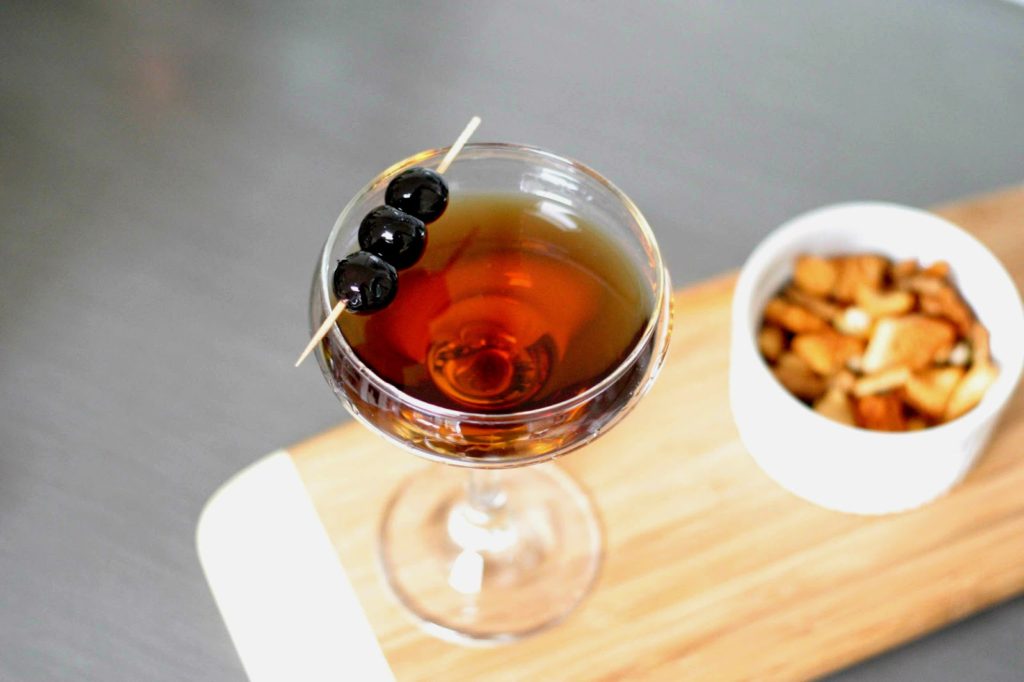People can be particular about their cocktails. But when it comes to certain drinks, some people become militantly so. Take David Wondrich’s Esquire article on the Manhattan, for example. He says to stir your Manhattan, but if you prefer to shake it, “There’s nothing wrong with that, really…. If you like your Manhattan cloudy and topped with an algae-like foam, shake away.” Message received. He is similarly firm on the topic of bourbon vs. rye in a Manhattan: “For a real Manhattan, you need rye whiskey. No amount of fiddling with the vermouth and bitters can save this drink if you’ve got bourbon in the foundations; it’s just too sticky-sweet.”
So imagine my distress when I go to make my Manhattan for this post and remember that I’ve run out of rye. I consider moving on to the next drink on my list, but the thought was a bit disappointing; I was looking forward to the Manhattan. I eye the bottle of Four Roses Bourbon on the bar. I glance around. No one is watching. Certainly not David Wondrich. Quietly, I reach for it.
In all seriousness, I don’t think most people would fault you for making a bourbon Manhattan. While trying to decide whether to pair my shameful bourbon with Punt e Mes or another sweet vermouth, I came across this post at Cocktail Buzz that compares rye vs. bourbon and Punt e Mes vs. Carpano Antica Formula (aka everybody’s-favorite-sweet-vermouth-that-I-have-yet-to-try) in a Manhattan. I was pleased to hear that they liked all of the combinations. They did advise that Punt e Mes would give a spicier, less sweet cocktail than the Carpano Antico, so I used that in my bourbon Manhattan to avoid the “sticky-sweet” flavor that Wondrich warned against. Was it a really, truly good Manhattan? I thought so, and that’s all that matters.
Still, I look forward to the day when I’m enough of a cocktail snob to be that opinionated. It’s what I aspire to.
History: The traditional story of the Manhattan’s creation is that it was developed at the Manhattan Club in New York in 1874 for a party thrown by Jennie Jerome Churchill, the wife of Randolph Churchill and mother of Winston Churchill, to celebrate the election of New York governor Samuel J. Tilden. (Tilden would later go on to win the popular vote in the 1876 presidential election, but lose to Rutherford B. Hayes in the electoral college, a situation much like what happened in the 2000 elections.) However, this story cannot be accurate, as Lady Churchill was in England at this time, giving birth to Winston. There were still two banquets held at the Manhattan Club for Tilden, and I’m not sure why no one seems to think the cocktail might still have originated at one of them even if Jennie wasn’t present.
The other main contender is a man we only know as Black. Bartender William F. Mulhall, who worked at New York’s Hoffman House, claimed that Black had invented the drink in the 1860’s. He said only that Black “kept a place ten doors below Houston Street on Broadway.” The story was printed in a 1923 issue of Valentine’s Manual of New York.
Either way, the Manhattan was popular enough by 1882 that the first known mention of it was made in print. In a short feature about mixed drinks, The Democrat of Olean, New York printed:
“It is but a short time ago that a mixture of whiskey, vermouth and bitters came into vogue. It went under various names – the Manhattan cocktail, Turf Club cocktail, and Jockey Club cocktail. Bartenders at first were sorely puzzled what was wanted when it was demanded. But now they are fully cognizant of its various aliases and no difficulty is encountered.”
Mahattan
2 oz. rye whiskey (or bourbon, if you dare)
1 oz. sweet vermouth
1-2 dashes Angostura bitters
Combine all ingredients in a mixing glass. Add ice and stir until chilled. Don’t shake unless you like algae-like foam. Strain into a cocktail glass or coupe, or serve on the rocks. Garnish with a maraschino or brandied cherry (or three).
Recipe from Esquire.






